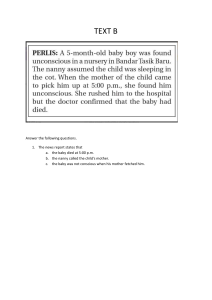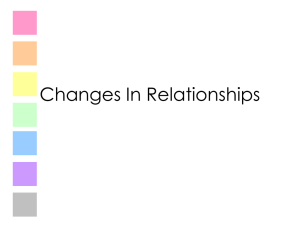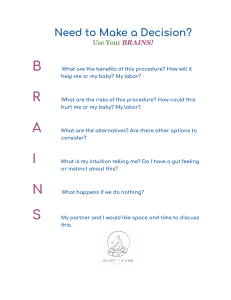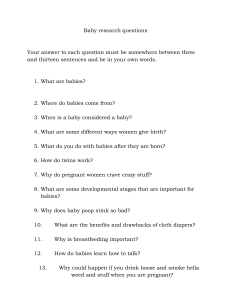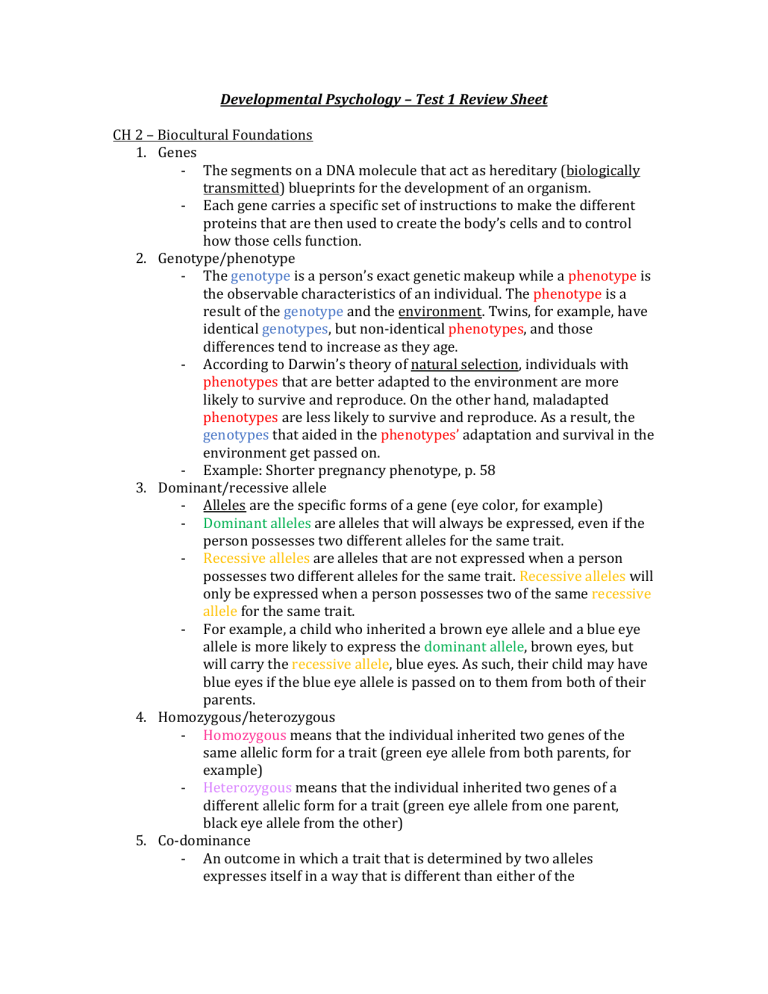
Developmental Psychology – Test 1 Review Sheet CH 2 – Biocultural Foundations 1. Genes - The segments on a DNA molecule that act as hereditary (biologically transmitted) blueprints for the development of an organism. - Each gene carries a specific set of instructions to make the different proteins that are then used to create the body’s cells and to control how those cells function. 2. Genotype/phenotype - The genotype is a person’s exact genetic makeup while a phenotype is the observable characteristics of an individual. The phenotype is a result of the genotype and the environment. Twins, for example, have identical genotypes, but non-identical phenotypes, and those differences tend to increase as they age. - According to Darwin’s theory of natural selection, individuals with phenotypes that are better adapted to the environment are more likely to survive and reproduce. On the other hand, maladapted phenotypes are less likely to survive and reproduce. As a result, the genotypes that aided in the phenotypes’ adaptation and survival in the environment get passed on. - Example: Shorter pregnancy phenotype, p. 58 3. Dominant/recessive allele - Alleles are the specific forms of a gene (eye color, for example) - Dominant alleles are alleles that will always be expressed, even if the person possesses two different alleles for the same trait. - Recessive alleles are alleles that are not expressed when a person possesses two different alleles for the same trait. Recessive alleles will only be expressed when a person possesses two of the same recessive allele for the same trait. - For example, a child who inherited a brown eye allele and a blue eye allele is more likely to express the dominant allele, brown eyes, but will carry the recessive allele, blue eyes. As such, their child may have blue eyes if the blue eye allele is passed on to them from both of their parents. 4. Homozygous/heterozygous - Homozygous means that the individual inherited two genes of the same allelic form for a trait (green eye allele from both parents, for example) - Heterozygous means that the individual inherited two genes of a different allelic form for a trait (green eye allele from one parent, black eye allele from the other) 5. Co-dominance - An outcome in which a trait that is determined by two alleles expresses itself in a way that is different than either of the contributing alleles (Mom’s blood is Type-A, Dad’s is Type-B, and baby is Type-AB) 6. How to fill out a punnett square D Dad D Mom D DD DD d Dd Dd Dad R Mom r Rr r r rr Rr rr 7. Sex linked traits - Traits that are attached to either the x or y chromosome. Usually, sexlinked characteristics will be attached to the x chromosome, meaning that males are more likely to have genetic disorders. Females have two x chromosomes, so if one chromosome is sick/carrying a mutation then the healthy x chromosome can sort of take over. Males have only one x chromosome, however, so if that chromosome is carrying a trait then they are more likely to have that trait. - Red-green color blindness, hemophilia, and muscular dystrophy are xlinked. 8. Dominant/recessive traits Dominant Trait (Phenotypic Expression) Recessive Trait (Phenotypic Expression) Brown eyes Grey, green, blue, or hazel eyes Curly hair Straight hair Dark hair Light or blond hair Thick lips Thin lips Roman nose Straight nose Earlobes free Earlobes attached Cheek dimples No dimples Farsightedness Normal vision Type A and B blood Type O blood Rh-positive blood Rh-negative blood Normal, healthy blood cells Sickle cell anemia Huntington’s disease Normal brain/body maturation Normal respiration Cystic fibrosis 9. Canalization - Ensures that the development of certain essential traits (i.e. communicating and forming relationships) is not easily diverted by environmental variations. Low-plasticity traits are considered canalized traits. CH 3 – Prenatal Development and Birth 1. Prenatal development - Germinal period (conception – 8/10 days) - At this point, the future baby is called a zygote - Stages of Germinal Period: Cleavage Mitosis, or cell division Heterochrony -> Heterogeneity Heterochrony is the concept that cells develop at different rates, some faster and more than others. This leads to heterogeneity, which is the concept that there are differences in the development of the body. This explains why the brain and heart will develop faster than, say, the kidney and limbs. Implantation When the zygote finds a comfortable spot to attach to on the uterine wall and decides to stay there. - Embryonic period (8/10 days – 8 weeks) - At this point, the future baby is called an embryo - Nutrition and Protection Amnion – a thin, tough, and transparent membrane that holds the amniotic fluid and embryo Placenta – a barrier/filter to which the umbilical cord is attached - Embryonic Growth Ectoderm: skin, nails, teeth, lens of eye, inner ear, Central Nervous System Endoderm: digestive system, lung Mesoderm: muscles, bones, circulatory system, inner skin Cephalacaudal vs. Proximodistal development pattern - Cephalacaudal = head to toe - Proximodistal = center out (proximity -> distance) - Sexual Differentiation happens around 6 weeks If more androgens – like testosterone – then embryo becomes male If more estrogens – like estradiol – then embryo becomes female - Fetal period (9 weeks – birth) - At this point, the future baby is called a fetus - Sensory capacities The fetus can sense motion around 5mo Can hear around 5-6mo Can start seeing at 26 weeks (6.5mo) - Fetal Activity (kicking and such) starts around 4mo Fetuses can learn in the womb -> Cat in the Hat study showed that babies, once born, will recognise a book that was read to them as a fetus. 2. Teratogens (those covered in class) - Prescription Drugs are an example of teratogens, things in the environment that can cause irregular development. Teratogens may lead to abnormalities and death. - Examples of teratogens: Caffeine (effects: low birth weight, bone growth) Tobacco (effects: low birth weight, linked to spontaneous abortion) Alcohol (effects: Fetal Alcohol Syndrome) Marijuana (effects: low birth weight, causes neurological problems) Cocaine (effects: stillbirth, low birth weight, stroke birth defect) Methamphetamine (effects: low birth weight, stroke) Heroin & Methadone (effects: baby born with addiction, respiratory illness, low birth weight) 3. Stages of labor - Stage 1- Uterine contractions cause cervix to dilate - Early contractions will last 30-60 seconds and happen every 20 minutes or so - As the cervix dilates more, contractions will last longer and become more frequent - The cervix is fully dilated at 10cm dilation - Stage 2 – Contractions are no more than a minute apart, baby is pushed through cervix and out, hopefully head first - Stage 3 – Placenta separates from uterine wall and is also pushed out 4. Culture & childbirth - Different cultures have different methods and practices - In the US, it is the norm for mothers to go to the hospital, and many of them will use medication to help with the pain of childbirth - Pain management in the US: Anesthetics – dull overall feelings Analgesics – reduce perception of pain Sedatives – reduce anxiety - C-sections are also quite common as a medical intervention, or as an option for planned delivery 5. Newborn’s condition - Physical - Apgar scoring system: checks for a newborn’s heart rate, respiratory effort, muscle tone, reflexes, irritability, and color. Baby is scored out of 3 on each category. - Some newborn reflexes: Rooting – nipple search reflex Moro – baby’s arms and legs spread out when “falling” Babinski – baby’s toes fan out when soles are stroked Blinking – it’s a reflex for babies, they will win a blinking contest Stepping – it’s a reflex, no one knows why Grasping – babies will close their fingers around anything they can feel in their hands - Behavioral - Brazelton Neonatal Assessment Scale: this scale tests a baby’s behavior and temperament with a range of behaviors that are normal for babies Orientation to animate objects - does the baby orient themselves towards people or interesting/new objects Pull to sit – does the baby flex neck muscles in anticipation for sitting when pulled to a sitting position Cuddliness – is the baby cuddly, does the baby seek cuddles and physical comfort, is the baby comfortable with hugs and cuddles Defensive movements – does the baby try to dislodge a light cloth on their face or does the baby not react, is there a reflex to save themselves Self-quieting activities – can the baby quiet themselves and calm themselves, activities like thumb sucking, caressing their arms or hair, etc 6. Average healthy baby - The average baby will be born between 37 and 43 weeks and weigh between 7 and 7.5lbs. The average baby will also be approximately 20in. long, and their hands and feet might be slightly blue for the first weeks of life. CH 4 – Infancy: The First 3 Months 1. Physical growth in first 3 months Body Growth o In 12 weeks, baby will have gained 6lbs and 4in o Breast feeding can be an influential factor in this physical growth o Breast feeding helps to balance hormone levels in mom and reduces the likelihood of postpartum depression so baby gets better care o Breast milk is also generally healthier for babies, they’re less likely to gain too much weight for example since the milk is made specifically for them, with all the nutrients they need, no more, no less Skull Growth o A newborn’s skull has soft spots, known as fontanels, that are there to: o Let the baby come out of mom o Let the baby’s brain grow into the right size 2. Brain development in first 3 months Central Nervous System o The CNS is made up of the brain stem, the spinal cord, and the cerebral cortex o Neurons are the cells most active in the CNS o Neurons are made up of the axon, the soma (cell body), dendrites, and the terminal buttons o Axon: the long part of the neuron; can be covered by the myelin sheath which is a coating that insulates the axon and speeds up the signal o Soma: the cell body, where the nucleus is; this is also the area where we’ll find dendrites o Dendrites: the receivers of the cell; dendritic spines are related to arborization; also related to synaptogenesis, the creation of new synapses and neuron highways o Terminal buttons: also known as telodendrion; this is where the neurotransmitters that get sent to the synapse are; the senders of the cell Experience-Expectant o The brain is pre-programmed for certain things; in these cases the stimulus needs to be given by a certain time or the window of opportunity closes and it is much harder, if at all possible, to learn those skills o Language is an example of an experience-expectant skill o This is related to synaptogenesis. In infancy, this is called exuberant synaptogenesis, and after a period of time a process called synaptic pruning happens. This gets rid of inactivated synapses, hence why there is a window of opportunity. Experience-Dependent o This is related to arborization, or the process of creating new dendritic spines in neurons. o When a person learns something new, their brain creates new dendritic spines, the learning of these skills depends entirely on whether a person will live through the right experience and learn the right things. 3. Sensing the environment - Methods for testing: EEG (measures electrical activity in the brain) and habituation (response to a stimulus decreases as brain gets used to it) - Hearing: The most developed of the senses in babies. We reach adult-like hearing by 10. Newborns have the ability to hear every phoneme (the smallest unit of sounds recognized as language) and will lose that ability over time - Vision: Newborns are basically blind it’s not until they reach 7-8 months that their vision is adult-like Visual acuity: sharpness; babies have none at first Visual scanning: look around, how babies learn at first Color perception: babies start seeing colors around 2-3 months (same time they start having coordination between their right and left eyes) and see fully in color around 6 months. Patterns and objects: babies start having a preference for some patterns around 2-3 months Perception of faces: babies prefer moving faces, and they like actual faces better. They also find faces with features (no matter the placement) more interesting than blank faces - Taste and smell: research implies that babies’ taste buds may be fully developed by the time they’re born Babies that are 2hr old make the same face as adults when they taste certain things (like lemons) - Intermodal perception: In short, all senses are inner-connected which is how babies learn about the world; they use different modes simultaneously to learn. 4. Reflexes: Around 3mo, some of the newborn reflexes go away, and others become voluntary actions, done with a purpose. Blinking and grasping, for example, remain as voluntary actions, while the Babinski reflex will just disappear 5. Learning theories: - Classical conditioning – conditioned response Pavlov’s experiment on his dogs, conditioned response Watson’s experiment on Albert, condition emotional response Classical conditioning works by: o Using a Neutral Stimulus (NS) at the same time as an Unconditioned Stimulus (US) to get its Unconditioned Response (UR) to become a Conditioned Response (CR) to the NS, which becomes a Conditioned Stimulus (CS) i.e. Food (US) makes dog salivate (UR), uses bell (NS) every time dog eats, dog eventually starts salivating (CR) to bell ringing (CS) i.e. Loud sound (US) makes baby cry (UR), loud sound is used while baby is touching fluffy cat (NS), overtime baby starts crying (CR) every time he sees fluffy cat (CS) - Operant conditioning – increase/decrease behavior Reinforcement increases a behavior Punishment decreases a behavior Positive adds something Negative removes something Positive Reinforcement Negative Reinforcement Adds something to increase behavior - Gives money for chores Removes something to increase behavior - Less chores if good grades Positive Punishment Negative Punishment Adds something to decrease behavior - Gives spanking after cursing Removes something to decrease behavior - No TV after slamming door 6. Temperament - There are three baby temperaments: Easy, Difficult, and Slow-to-warm-up - A temperament is a consistent emotional and behavioral characterization across situations, or in other words, how a baby acts across different situations - A baby’s temperament is determined, in part, by their: Activity level Rhythmicity (regularity of biological functions) Approach withdrawal (response to newness) Adaptability threshold and intensity of reaction (how long it takes a baby to get used to things and how strong their reaction is to new things) Quality of mood (always happy/always grumpy/big crier/etc) Distractibility (how easily a baby gets distracted/how well they can focus) Attention span or persistence (this relates to distractibility; how well can they focus, for how long) 7. Coordination w/social world - At this age, all babies do is sleep, eat, and cry - Sleeping: A 1mo baby will sleep 16.5hrs a day on average; a 4mo baby will sleep 15hrs a day; a 16mo baby will sleep 14hrs, etc - Feeding: demand (baby cries for food) vs schedule (baby eats at specific times) There is no right or wrong, it is entirely dependent on the baby, the parents, the environment, etc - Crying: Baby’s only way to communicate; It is important for guardians to find out why a baby is crying and to address it (thankfully, parents usually can hear the difference in cries and can tell their child’s needs from it) CH 5 – Physical and Cognitive Development in Infancy 1. Physical growth in infancy - Size and shape Newborns will weigh 7-8lbs and be about 20in in length By 1yo, babies will weigh 20-22lbs and be about 28-30in in length By 2yo, the physical development slows down, babies will start teething around this time Genes, diet, socioeconomic status, parents’ mental health status, etc, are all factors that can restrict growth during that period of development - Musculoskeletal system – this is the period of time where ossification starts happening. The bones start hardening, especially the tips, and babies start having less cartilage. - Note: Girls develop fast than boys In prenatal development, girls are about 3 weeks ahead Then 4-6 weeks ahead at birth And girls typically reach puberty about 2 years earlier than boys do 2. Brain development in infancy - In terms of behavior, babies will reach an important milestone around 7-9 months. They start regulating their emotions (pouting while deciding whether they can handle their emotions or not), they start cuddling their stuffed animals for comfort, and seek cuddles as comfort as a whole, and their attention span starts to get a little longer. - In terms of the brain itself, the first two years of life are critical for brain development. Brain deprivation can happen but if babies are adopted/taken care of properly by 6mo then long-term damage can be avoided. Between 624mo is when the sensitive period for deprivation is. Lack of stimulation during this period of time can cause a lot of lasting issues. 3. Motor development - Fine motor skills are the development and coordination of small muscles (i.e. fingers) Early fine motor skills: reaching and grasping o Has voluntary control by 3mo o Can gauge distance by 5mo o Has perfect execution by 9mo o Can drink from a cup and eat with a spoon by 12mo Later fine motor skills: manual dexterity o Can bang a spoon on a table and fling a ball by 1yo o Can throw ball, turn pages, hold cups/spoons, dress themselves by 2yo - Gross motor skills is the use of larger muscles Babies can creep and crawl by 8/9mo Can walk by 12mo Usually potty trained by 3.5-4yrs 4. Piaget’s theory of cognitive development (substages of sensorimotor) - Sensorimotor stage lasts from birth to 2yrs Substage 1: exercising reflex schemas (0-1.5mo) o Baby reflexes Substage 2: primary circular reactions (1.5-4mo) o Primary because it starts with babies, circular because it ends with them o Babies use themselves as a source of learning o Habits will start around here, thumb sucking, hair touching, etc Substage 3: Secondary circular reactions (4-8mo) o Reproducing interesting events 5. 6. 7. 8. 9. o Secondary because babies now use the environment around them to learn as opposed to themselves Substage 4: Coordination of secondary circular reactions (8-12mo) o Emergence of intentionality: reaching a goal; object permanence o Baby has a goal in mind for most actions Substage 5: Tertiary circular reactions (12-18mo) o Exploring by experimenting: trial and error o Baby is testing limits at this stage (throw toy off high chair, see what happens) Substage 6: Beginning of symbolic representation (18-24mo) o Representation: pretend play/symbolic play o Baby starts using imagination for play Object permanence - Babies start to understand it around 7-8 months, but generally won’t fully understand it for a while longer. Separation anxiety usually starts around 2yrs and is in part due to baby not fully understanding permanence (if mom leaves the room, baby may feel abandoned, stressed, etc, baby doesn’t fully get that mom is still there, still exists, and will come right back) - Relates to A not B task, and violation of expectation. A not B uses the concept of object permanence Violation of expectation relies on the idea that baby understands object permanence A not B task - Theories: muscle memory (toy is in spot B but baby’s body is used to reaching for spot A), actual memory (forgot if spot A or B) - Built on object permanence - Memory, perseveration: capture error, repetition, etc all play a role Possible event/impossible event - Violation of expectation - Possible event: what is expected did happen i.e. short carrot passed by short wall and was not seen from behind the wall - Impossible event: what is expected did not happen i.e. tall carrot passed by short wall but was not seen from behind the wall Infants reasoning abilities about objects - Infants can count, or at least understand if the count is wrong (teddy bears in a box) - Infants can understand cause-and-effect (blocks on top of each other example) - They can understand categorizing Can understand context, for example (plush dog can pretend drink, so can plush bunny, but toy train cannot) Attention & memory in infancy - Attention Phase I: stimulus detection reflex - o Heart rate increases slightly Phase II: stimulus orienting o Drastic drop in heart rate with new stimulus Phase III: sustained attention o Heart rate remains slow Phase IV: attention termination o Baby is done with stimulus, heart rate goes back to normal Memory Implicit memory is ability to recognise Explicit memory is ability to recall Babies have pretty bad explicit memory, in part because they don’t have much experience to recall o It gets better as we get older, until we reach a certain age and then it goes back down to being relatively crappy o It’s like a bell shape CH 6 – Social and Emotional Development in Infancy 1. Emotion & theories of emotional development - Roles and aspects of emotion: Physiological aspect (physiological changes, tears, hormonal changes, etc) Communication function (communicating how one feels through physical change for example: smiling to say hi to someone, laughing at a joke, etc) Cognitive aspect Action aspect - Theories of emotional development Biological perspective o Universal emotions: joy, fear, anger, surprise, sadness, disgust Cultural perspective Gradual differentiation o Positive or negative feelings Differential emotions o Biology (early feelings are similar to feelings in adulthood) Emotions as Ontogenetic Adaptations o Survival and development I got a covid booster and a flu shot around this time and my arm has been heavy and sore since, notes are less clear and specific because typing with fresh vaccines in your arms is really hard. Not an excuse, just an explanation. 2. Patterns of attachment - Phases of Attachment Pre-attachment phase (birth – 6 weeks) Attachment in the making (6 weeks – 6 to 8 months) Clear cut attachment (6 to 8 months – 18 to 24 months) Reciprocal relationship (18 to 24 months and older) - Patterns of Attachment Secure - Baby uses mom as security blanket o If mom leaves room, baby becomes slightly distressed, calms down when mom comes back in the room Avoidant – Insecure attachment; mom is not security blanket o Whether mom is in the room doesn’t matter; mom can leave the room and come back and baby won’t necessarily react much Resistant – Insecure attachment; mom is not security blanket o When mom leaves, baby becomes distressed, baby does not calm down when mom comes back in; may be sullen, continue crying, etc Disorganized – Insecure attachment o No specific, organized patterns in baby’s attachment to mom 3. Cause of variation in patterns of attachment - Family context Maternal depression/guardian mental health, socioeconomic status, single parent vs two parents (even if separated) - Out of home care can affect how a child’s attachment develops Baby sees nanny more than mom or dad, baby left at daycare from a young age, etc - Orphanages and adoption will also affect this Orphaned children usually have some level of social and emotional deprivation, their attachment to their caretakers and (hopefully) to their adopters may be affected by that - Cultural context Different cultures raise their kids differently, attachment will change 4. Social referencing - How babies learn by watching others. - If mom drops baby off at daycare for the first time, with lots of new people and toys, baby may look at mom for help to understand what to do, how to handle the new stimuli, etc This is social referencing - If baby is sat across from a new person, baby tries to make eye contact. If person looks in another direction, baby will look in that direction when they realize they are not making eye contact 5. Sense of self - Self recognition (baby looks into a mirror and reacts to reflection by waving, smiling, etc) happens around 3mo Self awareness (baby looks into a mirror and knows it’s a reflection) does not happen until 18mo - Self-conscious emotions come from social awareness Babies can start feeling embarrassed, proud, ashamed, guilty, or jealous when they start getting that social awareness - Trust vs mistrust and Autonomy vs shame and doubt Both are stages babies go through when they are a little older, depending on attachment pattern and parenting style, babies will handle these stages differently

